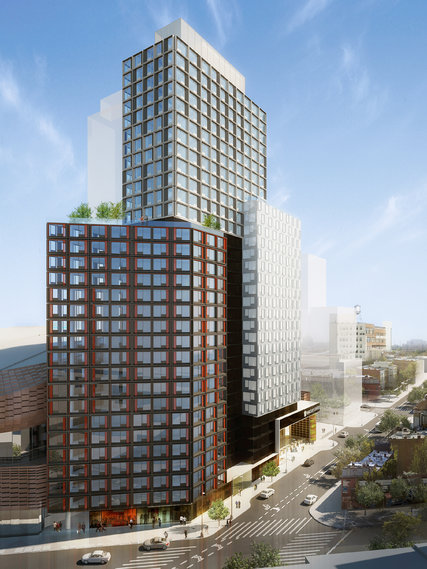At 32 stories, the B2 residential tower at Atlantic Yards near Brooklyn has been widely lauded as a bellwether for modular construction. But since construction started about 18 months ago, only five of the floors have been built—and developer Forest City Ratner Companies now has a Chinese partner that will move forward on the next three residential buildings, using conventional construction.
According to a report in the New York Times, Forest City Ratner's development partner, Greenland Holding Group, will now have a majority stake in the 22-acre Atlantic Yards mixed-use project. The Shanghai-based firm will oversee the next three residential tower projects, while Forest City Ratner continues to move forward with B2. Completion of the 348,000-sf modular tower, comprising 930 modules and 363 apartments, had been moved to late 2015, more than a year later than planned.
MaryAnne Gilmartin, Forest City Ratner's chief executive, says technical difficulties have been substantial, both at the nearby factory that's creating the modules and on the Atlantic Yards job site. “It’s been terribly frustrating," she told the New York Times. "But I don’t think this is a referendum on modular. The best way to prove that this works is to build B2.”
The Building Team for B2 includes Skanska, FC + Skanska Modular (a collaboration between Forest City Ratner and Skanska, which is building the components), SHoP, and Arup.
Related Stories
| Aug 11, 2010
Great Solutions: Healthcare
11. Operating Room-Integrated MRI will Help Neurosurgeons Get it Right the First Time A major limitation of traditional brain cancer surgery is the lack of scanning capability in the operating room. Neurosurgeons do their best to visually identify and remove the cancerous tissue, but only an MRI scan will confirm if the operation was a complete success or not.
| Aug 11, 2010
Great Solutions: Collaboration
9. HOK Takes Videoconferencing to A New Level with its Advanced Collaboration Rooms To help foster collaboration among its 2,212 employees while cutting travel time, expenses, and carbon emissions traveling between its 24 office locations, HOK is fitting out its major offices with prototype videoconferencing rooms that are like no other in the U.
| Aug 11, 2010
2009 Judging Panel
A Matthew H. Johnson, PE Associate Principal Simpson Gumpertz & HegerWaltham, Mass. B K. Nam Shiu, SE, PEVP Walker Restoration Consultants Elgin, Ill. C David P. Callan, PE, CEM, LEED APSVPEnvironmental Systems DesignChicago D Ken Osmun, PA, DBIA, LEED AP Group President, ConstructionWight & Company Darien, Ill.
| Aug 11, 2010
Inspiring Offices: Office Design That Drives Creativity
Office design has always been linked to productivity—how many workers can be reasonably squeezed into a given space—but why isn’t it more frequently linked to creativity? “In general, I don’t think enough people link the design of space to business outcome,” says Janice Linster, partner with the Minneapolis design firm Studio Hive.
| Aug 11, 2010
BIM school, green school: California's newest high-performance school
Nestled deep in the Napa Valley, the city of American Canyon is one of a number of new communities in Northern California that have experienced tremendous growth in the last five years. Located 42 miles northeast of San Francisco, American Canyon had a population of just over 9,000 in 2000; by 2008, that figure stood at 15,276, with 28% of the population under age 18.








